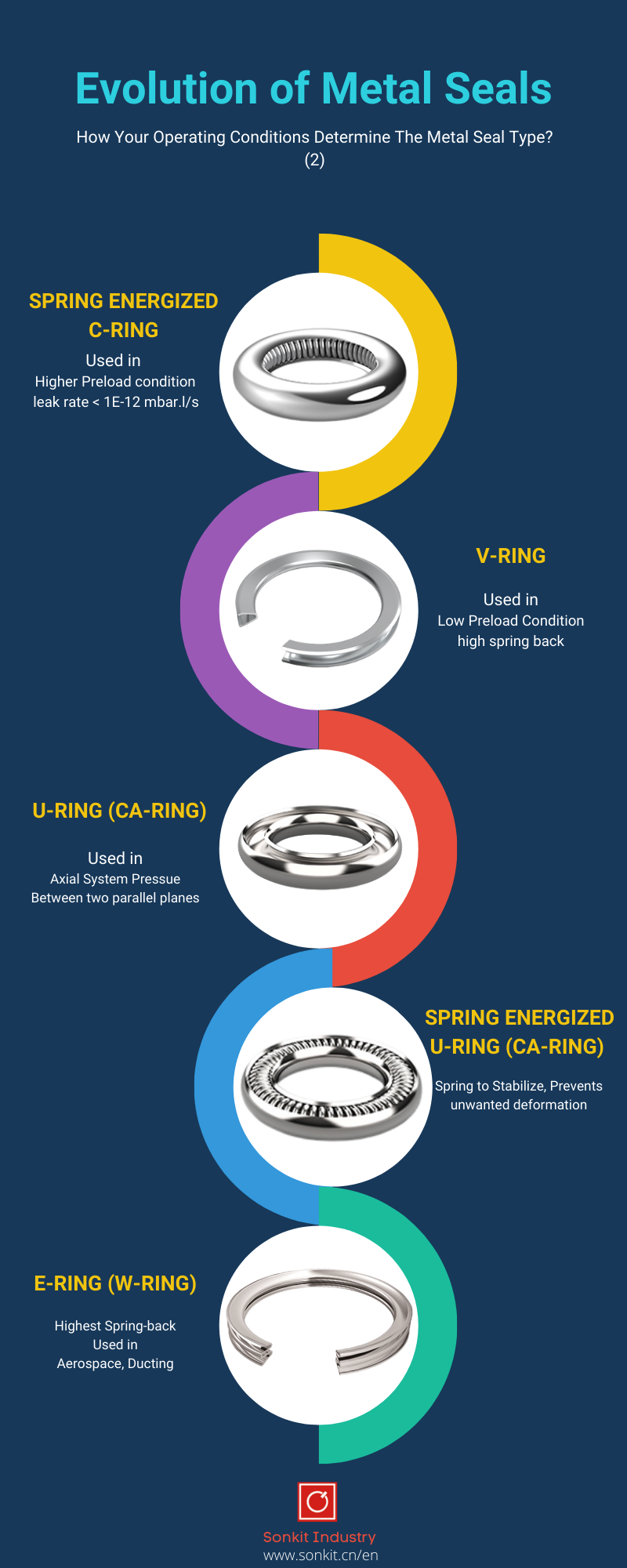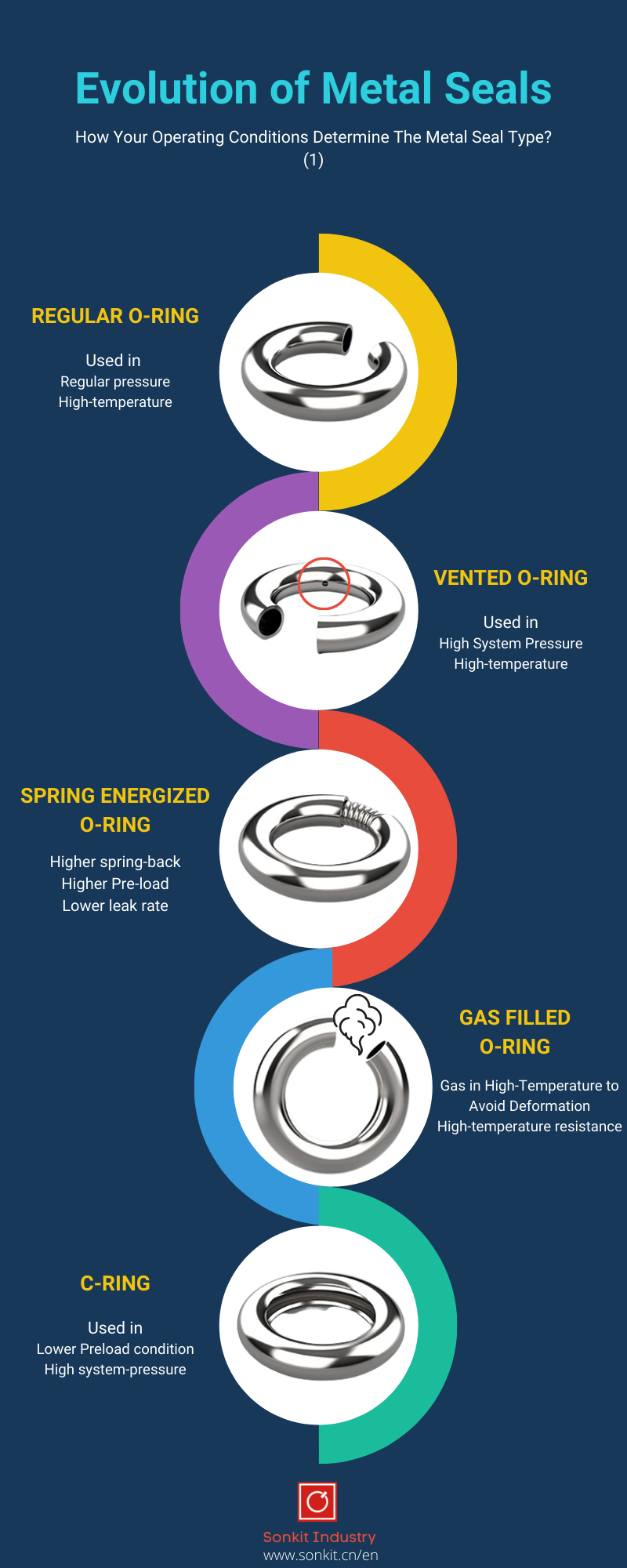Abstract
Metal Seal has been utilized for decades as a particular sealer in difficult working situations such as high temperature, high pressure, and dealing with radiation and corrosive medium. Until now, there have been so many various kinds of metal seals on the market to match different applications that new users are sometimes perplexed as to how to pick among them, and how to design a metal seal sealing solution becomes vital. If you're thinking about using a metal seal in your engineering design but aren't sure which metals to use, this article is for you. This article describes the development of metal seal types and explains how your operating conditions determine the metal seal type.
-
Metal O-Rings and their enhanced forms
Metal O-Rings are the most basic kind of metal seal. Metal O-Ring is made of high-strength metallic tubes and is intended for use in harsh working situations. They are a high-pressure/high-temperature sealing solution with negligible spring back. Because of its unique structure and material, metal O-rings may be used in working conditions such as high temperature (up to 750°C), cryogenic (down to -270°C), high pressure (up to 150Mpa), high vacuum (up to 1E-9 mmHg), and other harsh static sealing scenarios.
Normally, a standard metal O-ring is meant to be utilized under conditions of low pressure (less than 10bar) and high temperature (less than 500°C). If the pressure rises, vented holes in the Metal O-Ring (also known as Vented Metal O-Ring) are advised so that the system pressure may be used to improve the tightness. If the pressure is really high, such as more than 100Mpa, a spring within the Metal O-Ring tube might be considered. To deal with excessive pressure, the spring within may give suppleness.
In certain applications, the operating temperature is quite high (>600°C); in this situation, a gas-filled Metal O-Ring should be considered. At comparison to a standard Metal O-Ring, the gas within a gas-filled Metal O-Ring expands in high temperatures, making the metallic tube more difficult to deform.
-
Metal C-Ring and their enhanced forms
Some sealing applications are confined by flange loading, flange movement, or a combination of the two variables, thus a variety of metal seal designs, such as Metal C-Rings, are employed as an alternative to Metal O-Rings.
C-Rings are utilized in comparable applications as Metal O-Rings, but provide additional flexibility and lower flange loading requirements. The linear compression on assembly is comparable for flange seals, at around 20%, but the force needed to accomplish this is about half that of an equivalent metal O-ring. Because the C is exposed to pressure, it must be properly designed and installed for both external and interior pressure applications.
A kind of metal C-ring designed to offer high-integrity sealing in the nuclear sector and other applications where a minimal leak is needed. A tightly wrapped helical spring is enclosed by one or two metal jackets. When utilizing two metal jackets, the inner metal ring transfers energy from the spring to the outer metal layer. The outer layer is made of a variety of coating materials, including high-purity silver, and is meant to be more durable than the flange groove surfaces.
The application regions include vacuums up to 350 MPa and cryogenic temperatures up to 750°C. The spring adds extra tensile strength to account for flange movement. The compression of the spring for energization results in a greater flange loading than metal O- and C-rings. Compression to the design criteria of 16% requires 200–700N/mm.

In certain applications, such as gas turbines, swivels, valves, or turbochargers, a low bolt force is provided, but a significant spring back is required. If the leak rate requirement is low (such as 1E-7mbar*l/s), a metal V-Ring is appropriate for this application. Metal V-ring is built on a metallic "V" substrate; the preload need is substantially lower than the corresponding Metal C-Ring and Metal O-Ring, but the spring back performance is almost 10x that of Metal O-Ring and 4x that of Metal C-Ring.
-
Metal U-Ring (Metal C-Ring for Axial pressure)
Compared with Metal O-Ring, Metal C-Ring provide improved flexibility, so metal C-ring can also be designed to accommodate to axial pressure. In this case, it’s also known as metal U-Ring, where its substate is more like “U” shape. The typical applications for Metal U-Ring are piston seal, rod seal, Bolt, Valve application.
In some operating conditions like aerospace and ducting application, it’s high-temperature, requires much more spring back performance than V-Ring, but a much lower flange loading(5-25N/mm) can be provide. Then Metal E-Ring (W-Ring) is designed for these applications. The standard material for the seals is high-nickel alloy, N07718(Alloy 718). With the physical property of Alloy 718, Metal E-Ring can achieve the highest spring back.
Metal Seal Design is a systematic project. To choose the best metal seal type for your application, take into account not just your leak rate requirements, but also all of the working variables such as temperature, pressure, flange loading, and flange movement. If you are unsure which kind of metal seal to utilize in your application, please contact Sonkit for a best-fit solution.
If you have any questions about metal seals or need technical assistance, please contact Johnny at johnny@sonkit.cn or +86-139-1719-2435. (WhatsApp).
----------
SONKIT INDUSTRY


